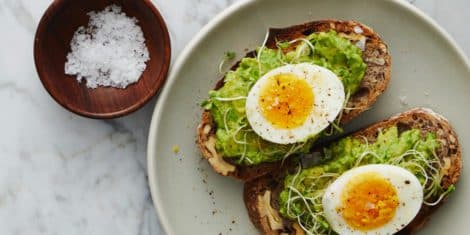Women’s Wellness and DNA

A Gene for Every Stage of Life

The female body is capable of so many things, from walking and dancing to climbing Mt. Everest and making other humans. Think about that last one for a second. Reproduction is a complex process, so it’s no wonder women’s bodies change so dramatically throughout their lifetime. How you experience these changes depends on a variety of factors, not least of which is your DNA.
A major milestone. Period.
Some girls welcome their first period with open arms (Hello, womanhood!). Others are a little less excited (Seriously, Mother Nature?!). Either way, it marks an important new stage in a girl’s life: the start of her reproductive years. Most begin menstruation between the ages of 12 and 13, although some will get it a little earlier or later than that. Diet, exercise, stress, and other environmental factors play a role, as does your DNA. By analyzing many locations in your genome, we can estimate whether you likely started your period earlier or later than average 1-3.
Ch-ch-ch-changes…
Any woman who’s woken up drenched in a pool of her own sweat will tell you: menopause doesn’t happen overnight. The process—which can take several years—starts with your ovaries producing less estrogen and ends with your last menstrual period. Most women reach menopause between the ages of 45 and 55, but some can get there as early as 40 or as late as 60. Just like with menstruation, a combination of environment and genetics determines when you’ll begin the process. If you have yet to experience “the change,” a look at your DNA can provide clues about when to expect it 2,4. Another way to predict when you’ll reach menopause? Call your mom! Her experience with it can tell you a lot about what yours will be, barring any major outside factors1.
No bones about it
Your body continues to change long after your last period. Those pesky hot flashes might be behind you, but you’ll likely face other challenges thanks to lower levels of estrogen. For example, did you know that women can lose up to 20% of their bone density in the 5-7 years following menopause2? We’re still learning a lot about how DNA may impact bone density, but it looks like some women might have a slight advantage 5-7. It turns out a variation in the EN1 gene can make you more or less likely to have higher bone mineral density.
Sleep habits and your DNA

Between work stress, the kids’ crazy schedules, and a never-ending to-do list, it’s no wonder you’re sleep-deprived. Even if you manage to get to bed on time—miracles can happen!—you might find yourself tossing and turning into the wee hours. And while your busy lifestyle certainly plays a role, don’t discount your DNA. We now know that certain genetic factors may influence your ability to fall asleep, stay asleep, and even get out of bed in the morning.
Early bird or night owl?
Love waking up with the sun? Or are you more of a “no talkie before coffee” kind of gal? Your preference for early mornings or late nights is known as your chronotype, and it’s at least partially determined by your DNA. Take the HCRTR2 gene 8,9. Variations in this gene might disrupt an important chemical process, making it more difficult for some to transition from being asleep to being awake.
Counting sheep or fast asleep?
Racing thoughts can contribute to sleeplessness, but it’s not all in your head. Some of it might be in your genes. Your DNA can influence how easily you fall asleep and even how well you sleep through the night. How? By affecting the rhythm of your internal clock. A variant (what we call a difference in your DNA) in the CRY1 gene, for example, is associated with Familial Delayed Sleep Phase Syndrome—a disorder that causes people to fall asleep significantly later than the norm 8,10.
Regular or decaf?
If you’ve ever been tempted to curl up in your cubicle for a brief siesta, you know the draw of a 2pm coffee run. There’s nothing quite like a jolt of joe to help you through the rest of your busy day. But depending on your DNA, you may want to skip that late-afternoon latte. Scientists have identified multiple genetic factors that could impact your ability to metabolize caffeine. A change in the DNA coding for the CYP1A2 gene, for example, can leave you feeling that caffeine buzz longer than others. And people with a certain ADORA2A variant tend to have an easier time falling asleep after a cup of coffee 11,12.
Of course, your DNA is only part of the equation. Diet, exercise, stress levels, and even your sleep environment all have a huge role to play. But exploring genetic factors can shed some light on your unique sleep needs—and that’s nothing to snooze at!
The genetics of eating well

The question is not “should you eat healthy?” The question is, “what should you eat to be healthy?” And the answer isn’t always so simple. That’s because everyone processes nutrients a little differently. For some, absorbing certain vitamins is a piece of cake (not literally!). For others, it’s more of a struggle. The good news is that your DNA can offer up important clues about your body’s unique nutritional needs.
Iron out the details
Abundant in beans, nuts, leafy greens and meats, iron is an important part of a healthy diet. Your body needs it to create red blood cells, giving you the energy you need to multitask like a boss. But getting enough can be extra challenging for some people, especially when you factor in the blood lost every month during menstruation. At the same time, the amount of iron one person needs can differ from that of another, and DNA may explain why. A variant (what we call differences in your DNA) in the TMPRSS6 may alter how your body regulates iron, making some women more susceptible to decreased iron levels, while others may be predisposed to higher levels 13,14.
Bring on the B12
One of eight essential B vitamins, B12 is kind of a big deal. Not only does it help your body produce red blood cells, it also aids in brain function, metabolism, and even DNA synthesis. It’s almost exclusively found in animal products, but lots of foods are fortified with the stuff, including many popular breakfast cereals. B12 is stored in your body for many years, too, making deficiency extremely rare. Still, it’s a good idea to keep an eye on it, particularly if you’re vegan or vegetarian. Though diet plays a major role in determining our B12 levels, some people’s DNA predisposes them to having higher levels of it in their blood. This is caused by a change in the FUT2 gene, which may be influencing B12 levels via the gut microbiome 15,16.
Gotta love those good fats
You hear a lot about omega-3s, but what are they exactly? Long chain polyunsaturated fatty acids (also known as LC-PUFA), omega-3s are found primarily in foods like fish, flax seeds, chia seeds, and walnuts. They help keep your brain, bones, and eyes healthy—definitely not something you want to skimp on! We’re still learning a lot about how the body processes “good” and “bad” fats, but we’re pretty sure your genes play a role. For example, there’s some evidence that variations in the FADS genes might affect a person’s ability to synthesize fatty acids like omega-3s 17,18.
It’s important to keep in mind that DNA sequencing won’t tell you if you’re deficient in a particular nutrient—just whether you’re genetically predisposed to having lower or higher levels of it. (If you’re concerned you have a deficiency, talk to your doctor.) But by knowing how your body is likely to absorb and process these nutrients, you can start taking steps toward a better diet and a healthier you.
To lose or not to lose?

Intermittent fasting. High-fat keto. Goat yoga. It seems like every other day there’s a new diet or fitness craze. And while they vary greatly in effectiveness (and adorableness), they can make deciding on a weight loss plan that much more confusing. What we know for sure is that losing weight is some function of calories in versus calories out. But there are many factors in our lives that can influence this equation, including our DNA.
Let’s get physical
For some women, a few weeks of spin class and bam, the weight starts falling off. For others, the results are a little more subtle. When it comes to exercise and weight loss, everyone’s experience is a little different—and part of that might be genetic. Women who have inherited certain changes in the FTO gene might find that exercise is extra beneficial to their weight loss regimen 19-21. If that’s not you, it might be a good idea to focus a little more on diet. Either way, there’s no question that exercise is a very good thing. It helps prevent heart disease, diabetes, and cancer, to name a few. Heck, it even makes you feel better.
What the fat?
Your body needs some fat, especially the “good” kind (think: avocados, nuts, and seeds). And then there are the saturated fats, a.k.a. the ones you really crave: ice cream, cheese, butter, did we mention cheese? Reducing saturated fat intake benefits everyone—for weight loss and otherwise. But for some with a particular genetic variant (what we call differences in your DNA), the impact is slightly more substantial. Those with a certain version of the APOA2 gene might be more susceptible to weight gain with a diet high in saturated fat 22,23. These folks might want to go easy on the gouda.
A view of the Mediterranean
Dreaming of sunshine and siestas? You might not be able to live on a Mediterranean island, but you can eat like you do. Rich in plant foods and “good” fats like fish, olive oil, nuts, and seeds, the region’s diet is known for its healthfulness. But for some, it may be extra beneficial when it comes to weight loss. Those who inherited a specific version of the PPARG gene appear to lose slightly more weight on a Mediterranean diet compared to a standard low-fat diet 24. Bring on the baba ganoush!
So should you hit the gym? Absolutely. Should you limit fat in your diet? Probably. These lifestyle changes benefit just about everyone. But knowing your genetic predisposition might help you take a more personalized approach to weight loss. Goats optional
Sun, skin, and sequencing

Ever wonder why your sister’s covered in freckles and you’re not. Or why your partner always gets a nice golden tan while you end up more lobster-like. Hint: It starts with your DNA.
All about that melanin
A tan is your body’s first line of defense against the sun’s harmful ultraviolet (UV) rays. While you’re out having fun in the sun, your body is working extra hard to increase its production of melanin—a skin pigment that helps prevent DNA damage. We can look at over 1,000 genetic markers to see whether you’re likely to tan a lot, tan moderately, or get a sunburn in response to sun exposure 25,26. Whatever your result, don’t rely on a tan to protect you from the sun. It’s a good idea to wear sunscreen every day, but especially when you’ll be spending time outdoors.
And cute to boot
Freckles are another outcome of the same skin-protecting process. Like tanning, they’re the result of an increase in melanin production. The difference is that instead of the melanin pigment being distributed evenly throughout the skin (a suntan), people with freckles produce melanin in clumps. So some skin cells get darker while others remain lighter. Why? Scientists still have a lot to learn, but one explanation might be found in the MC1R gene. People with a certain variant (what we call differences in DNA) in that gene appear more likely to have freckles 25,27. Fun fact: The same variant is also associated with red hair and fair skin. But you can have freckles and not have red hair, and vice versa. It all has to do with how many copies of the MC1R variant you carry, along with other factors we’re still uncovering.
DNA influences other aspects of your skin, too. There appears to be a strong genetic component to everything from acne to wrinkling to melanoma. But you can do a lot to help keep it healthy and beautiful, regardless of what your genes say.
What are people saying about Women’s Wellness?
No two women are alike. But you knew that! What you might not know is whether a you get a little extra help from a low-fat diet. Or why you’ve always struggled to fall asleep at night. DNA can’t give you all the answers, but it can certainly add a little color to how we view of ourselves and how approach our overall wellness.
But don’t take our word for it—here are a few choice quotes from individuals who’ve had a chance to try Women’s Wellness by Helix for themselves.

Michelle
Insight: Circadian rhythm
“I am not an early bird and never have been. I’ve always had trouble going to bed on time and getting out of bed in the morning. Clearly – I don’t have the best sleeping habits! It was interesting to learn some of the factors that might be impacting my sleep quality. I learned about circadian rhythm – and my internal body clock is genetically predisposed to make me a night owl. Explains a lot!”
Insight: Caffeine metabolism
“I’m that person with a triple-shot iced coffee in their hands 24/7, yet honestly I never feel too much of a difference from the caffeine – I can literally down a coffee and then take a nap. The Women’s Wellness app showed me that my DNA suggests that I am more likely to metabolize caffeine faster than most – aka a cup of coffee might not wake me up or affect me as much as most other people. Finally it all makes sense!”
Insight: Waist size
“People always ask me how I get my waist to stay so small and I always tell them—lots of coffee, wine, and cheese—and then make sure to dance in front of your mirror every morning when you brush your teeth. Aka—I have no idea. I’m definitely not as fit or active as I should be! The Women’s Wellness app explained to me that my DNA suggests that I am genetically more likely to have a smaller waist than average. Shout out to my DNA for picking up the slack!”

Ri
Insight: Mediterranean Diet Impact
“When choosing to make healthier food choices there is a plethora of options — each with its critics and fans. It’s difficult to decide which diet will be most effective for you as an individual. The Women’s Wellness app adds some guidance to dieting, helping you focus on the regimen which may be most beneficial for you and your nutritional needs.”

Sami
Insight: Exercise Impact on Weight
“I definitely notice the differences in my body when I exercise or don’t. I feel a lot better when I move more often…but wow, it’s hard to get up for 7am yoga! It was cool to see that the exercise classes I get to, actually might have a positive impact on my health. It’s definitely more motivation to get out of bed and move!”
Insight: Snoring
“My husband tells me that I snore a little, but I never had any proof to dispute him. Here it is, I’m likely a quiet sleeper! Even though this doesn’t give me the guarantee of being absolutely quiet, I can definitely bring this up the next time to remind him that it’s ‘likely a quiet snore’.”
Insight: First Menstrual Cycle
“I knew I got my period earlier than most of my friends, but I wasn’t sure why. It’s interesting to learn that I was likely to get my first menstrual cycle earlier due to my DNA. It made me talk to my mom and learn that she got hers early as well. Apparently, we are early bloomers!”

Opal
Insight: Exercise Impact on Weight
“I got to learn that I have a gene that shows I may have a higher likelihood to benefit from physical activity in regards to my weight. For someone that struggles with going to the gym regularly, definitely is an additional motivator to work towards having and maintaining a workout routine!”
Insight: Tan vs. sunburn
“Whenever I go to the beach, I’m not someone who burns easily, which is because I am more likely to tan than sunburn! I always use sunscreen and will continue to use sunscreen regardless, but fun to have another reason to be proud of my skin!”
Citations
- Steiner, Anne Z et al. “Mother’s menopausal age is associated with her daughter’s early follicular phase urinary follicle-stimulating hormone level.” Menopause (New York, N.Y.) vol. 15,5 (2008): 940-4. doi:10.1097/gme.0b013e31816429e5
- https://www.nof.org//srv/htdocs/wp-content/uploads/2016/02/Healthy-Bones-for-life-Clinician-Guide.pdf
- Unpublished algorithm for polygenic trait estimation developed by Helix based on genomic and phenotypic datasets from UK Biobank
- Gajbhiye, Rahul et al. “Complex genetics of female fertility.” NPJ genomic medicine vol. 3 29. 12 Oct. 2018, doi:10.1038/s41525-018-0068-1
- Zheng, Hou-Feng et al. “Whole-genome sequencing identifies EN1 as a determinant of bone density and fracture” Nature vol. 526,7571 (2015): 112-7.
- Mitchell, Jonathan A et al. “Rare EN1 Variants and Pediatric Bone Mass” Journal of bone and mineral research : the official journal of the American Society for Bone and Mineral Research vol. 31,8 (2016): 1513-7.
- “Healthy Bones For Life CLINICIAN’S GUIDE.” Resources for Professionals – MyNOF, National Osteoporosis Society, www.nof.org//srv/htdocs/wp-content/uploads/2016/02/Healthy-Bones-for-life-Clinician-Guide.pdf. Accessed on April 15, 2019
- Sehgal, Amita, and Emmanuel Mignot. “Genetics of Sleep and Sleep Disorders.” Cell 146.2 (2011): 194–207. PMC. Web. 10 Sept. 2018.
- Leonard, C S, and J P Kukkonen. “Orexin/hypocretin Receptor Signaling: A Functional Perspective.” British Journal of Pharmacology 171.2 (2014): 294–313. PMC. Web. 12 Sept. 2018.
- Patke, Alina et al. “Mutation of the Human Circadian Clock Gene CRY1 in Familial Delayed Sleep Phase Disorder” Cell vol. 169,2 (2017): 203-215.e13.
- Thorn, Caroline F et al. “PharmGKB summary: caffeine pathway.” Pharmacogenetics and genomics vol. 22,5 (2012): 389-95. doi:10.1097/FPC.0b013e3283505d5e
- Porkka-Heiskanen, Tarja. “Methylxanthines and Sleep.” Methylxanthines Handbook of Experimental Pharmacology, 2010, pp. 331–348., doi:10.1007/978-3-642-13443-2_12.
- Finberg, Karin E et al. “Mutations in TMPRSS6 Cause Iron-Refractory Iron Deficiency Anemia (IRIDA).” Nature genetics 40.5 (2008): 569–571. PMC. Web. 17 Oct. 2017.
- Benyamin, Beben et al. “Common Variants in TMPRSS6 Are Associated with Iron Status and Erythrocyte Volume.” Nature genetics 41.11 (2009): 1173–1175. PMC. Web. 17 Oct. 2017.
- Kashyap, Purna C. et al. “Genetically Dictated Change in Host Mucus Carbohydrate Landscape Exerts a Diet-Dependent Effect on the Gut Microbiota.” Proceedings of the National Academy of Sciences of the United States of America 110.42 (2013): 17059–17064. PMC. Web. 21 Dec. 2017.
- Anwar, Vinay Singh, et al. “Common variant in FUT2 gene is associated with levels of vitamin B12 in Indian population.” Gene, vol. 515, no. 1, 29 Nov. 2013, pp. 224–228., doi:10.1016/j.gene.2012.11.021. Web. 21 Dec. 2017
- Al-Hilal, Maryam et al. “Genetic Variation at the FADS1-FADS2 Gene Locus Influences Delta-5 Desaturase Activity and LC-PUFA Proportions after Fish Oil Supplement.” Journal of Lipid Research 54.2 (2013): 542–551. PMC. Web. 13 Dec. 2017.
- Tanaka, Toshiko et al. “Genome-Wide Association Study of Plasma Polyunsaturated Fatty Acids in the InCHIANTI Study.” Ed. Michel Georges. PLoS Genetics 5.1 (2009): e1000338. PMC. Web. 13 Dec. 2017.
- Corella, Dolores et al. “A High Intake of Saturated Fatty Acids Strengthens the Association between the Fat Mass and Obesity-Associated Gene and BMI.” The Journal of Nutrition 141.12 (2011): 2219–2225. PMC. Web. 17 Jan. 2018.
- Sonestedt, E, et al. “Association between fat intake, physical activity and mortality depending on genetic variation in FTO.” International Journal of Obesity, vol. 35, no. 8, 2010, pp. 1041–1049., doi:10.1038/ijo.2010.263.
- Castillo, Joseph J., Robert A. Orlando, and William S. Garver. “Gene-Nutrient Interactions and Susceptibility to Human Obesity.” Genes & Nutrition 12 (2017): 29. PMC. Web. 17 Jan. 2018.
- Corella, D., et al. “The -256T>C Polymorphism in the Apolipoprotein A-II Gene Promoter Is Associated with Body Mass Index and Food Intake in the Genetics of Lipid Lowering Drugs and Diet Network Study.” Clinical Chemistry, vol. 53, no. 6, 2007, pp. 1144–1152., doi:10.1373/clinchem.2006.084863.
- Zaki, Moushira Erfan, Khalda Sayed Amr, and Mohamed Abdel-Hamid. “ APOA2 Polymorphism in Relation to Obesity and Lipid Metabolism.” Cholesterol 2013 (2013): 289481. PMC. Web. 11 Oct. 2017.
- Garaulet, Marta et al. “PPARγ Pro12Ala Interacts with Fat Intake for Obesity and Weight Loss in a Behavioural Treatment Based on the Mediterranean Diet.” Molecular nutrition & food research 55.12 (2011): 1771–1779. PMC. Web. 12 Sept. 2017.
- Maddodi, Nityanand, Ashika Jayanthy, and Vijayasaradhi Setaluri. “Shining Light on Skin Pigmentation: The Darker and the Brighter Side of Effects of UV Radiation.” Photochemistry and photobiology 88.5 (2012): 1075–1082. PMC. Web. 13 June 2018.
- Unpublished algorithm for polygenic trait estimation developed by Helix based on genomic and phenotypic datasets from UK Biobank
- Praetorius, Christian, et al. “Sun-Induced Freckling: Ephelides and Solar Lentigines.” Pigment Cell & Melanoma Research, vol. 27, no. 3, Mar. 2014, pp. 339–350., doi:10.1111/pcmr.12232.